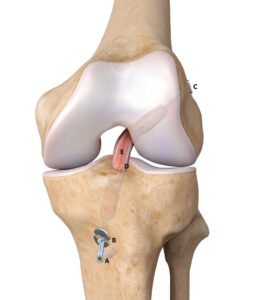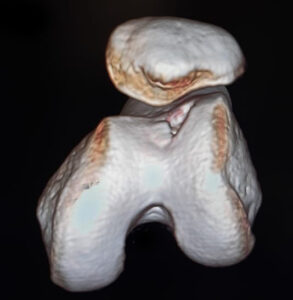ACL Reconstruction also known as Anterior cruciate ligament surgery involves repairing or reconstructing the ligament (ACL). The ACL, which joins the femur and tibia, is a crucial soft tissue component of the knee. ACL tears, whether partial or full, are a frequent occurrence among athletes. Complete ACL injuries are often treated with an ACL Reconstruction operation by sports medicine doctors and orthopedic surgeons, in which the torn ligament is replaced with a tissue graft to replicate the original ACL.

How can you determine if ACL Reconstruction surgery is necessary?
The decision for surgery relies on the extent of the ACL tear and the patient’s lifestyle. A fully torn ACL cannot self-repair. However, research suggests that some patients with a partial ACL tear may experience natural healing without surgery.
To discern between partial and complete ACL tears, a physician conducts two manual tests:
- Lachman test: The doctor attempts to pull the shin bone away from the thigh bone. If the ACL is torn but still intact, minimal or no movement occurs.
- Pivot shift test: The patient lies down while the doctor lifts their leg and applies rotational pressure to the knee.
A negative result indicates no bone shifting. For individuals with partial tears, delaying surgery may be advised to observe if the ligament heals spontaneously.
How soon should one get ACL reconstruction surgery done?
For a total tear of the ACL, reconstruction surgery is by and large planned for between three and six weeks after the damage happens. This permits aggravation in the region to die down. If surgery is performed as well early, patients may create a significant scarring reaction called arthrofibrosis.
Orthopedic specialists gage the fitting timing of surgery based on:
- whether other wounds require to be treated first
- the physical appearance of the knee
- the patient’s level of pain
- the patient’s extent of movement and quality of muscle control when flexing (twisting) or amplifying (fixing) the leg
Some proof proposes that postponing ACL Reconstruction surgery for six months or longer after damage diminishes a person’s chances of having a clinically critical result and leads to expanded rates of the requirement for future ACL reconstruction surgeries.
Just like, the ACL there is the Posterior Cruciate Ligament (PCL), which lies behind the ACL and acts as a link between the femur and tibia bones in the knee. However, it travels in a distinct direction from the ACL. One can have PCL injuries and thus patients can have surgery for the same, to correct it.
Causes & Symptoms
What causes ACL injuries?
The anterior cruciate ligament (ACL) can get hurt in different ways:
- Quickly changing direction
- Stopping suddenly
- Slowing down while running
- Landing wrong after a jump
- Getting hit directly, like in a football tackle
Studies have found that female athletes get ACL injuries more often than male athletes in certain sports. Some reasons for this might be differences in how physically fit they are, how strong their muscles are, and how well they control their muscles. Other reasons could be how their pelvis and legs are aligned, having looser ligaments, and how estrogen affects ligaments ACL Reconstruction surgery can be done, in order to treat the injuries.
What happens if you hurt your anterior cruciate ligament (ACL)?
You might hear a pop and feel like your knee suddenly can’t support you. Other common signs are:
- Pain and swelling: Your knee will swell up within a day of the injury. The swelling and pain might go away if you rest, but if you try sports again, your knee could feel wobbly, and you might damage the cushioning cartilage inside your knee (called the meniscus).
- Trouble moving your knee all the way
- Tender spots around the joint
- Pain when you walk